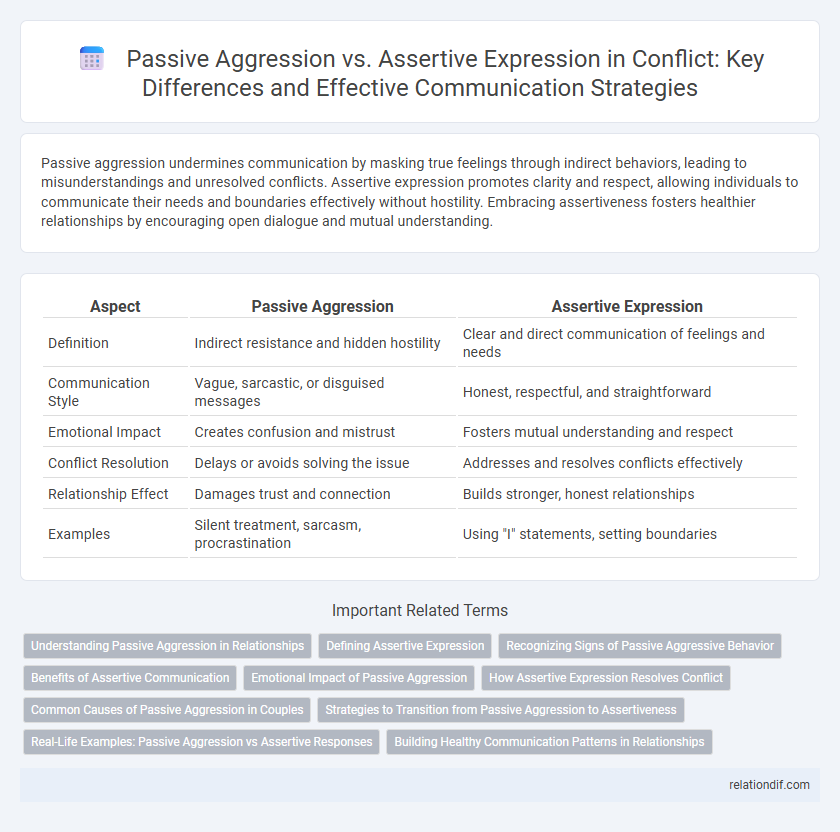Passive aggression undermines communication by masking true feelings through indirect behaviors, leading to misunderstandings and unresolved conflicts. Assertive expression promotes clarity and respect, allowing individuals to communicate their needs and boundaries effectively without hostility. Embracing assertiveness fosters healthier relationships by encouraging open dialogue and mutual understanding.
Table of Comparison
| Aspect | Passive Aggression | Assertive Expression |
|---|---|---|
| Definition | Indirect resistance and hidden hostility | Clear and direct communication of feelings and needs |
| Communication Style | Vague, sarcastic, or disguised messages | Honest, respectful, and straightforward |
| Emotional Impact | Creates confusion and mistrust | Fosters mutual understanding and respect |
| Conflict Resolution | Delays or avoids solving the issue | Addresses and resolves conflicts effectively |
| Relationship Effect | Damages trust and connection | Builds stronger, honest relationships |
| Examples | Silent treatment, sarcasm, procrastination | Using "I" statements, setting boundaries |
Understanding Passive Aggression in Relationships
Passive aggression in relationships manifests through indirect expressions of anger, such as sarcasm, procrastination, or silent treatment, which undermine clear communication and breed resentment. This behavior contrasts with assertive expression, where individuals communicate their needs and feelings openly and respectfully, fostering mutual understanding and conflict resolution. Recognizing passive-aggressive patterns is essential to improving relational dynamics and promoting healthier emotional exchanges.
Defining Assertive Expression
Assertive expression involves clearly and respectfully communicating one's thoughts, feelings, and needs without infringing on others' rights. It contrasts with passive aggression by promoting directness and honesty, fostering healthier conflict resolution and mutual understanding. Techniques include using "I" statements and maintaining calm body language to express oneself confidently and constructively.
Recognizing Signs of Passive Aggressive Behavior
Passive aggressive behavior often manifests through subtle signs such as sarcasm, backhanded compliments, and intentional procrastination, which undermine direct communication. Recognizing these behaviors involves observing inconsistencies between verbal expressions and nonverbal cues like eye rolling or sighing. Identifying patterns of avoidance and indirect resistance helps differentiate passive aggression from assertive expression, which is characterized by clear, honest, and respectful communication.
Benefits of Assertive Communication
Assertive communication fosters clear and honest expression of thoughts and feelings, reducing misunderstandings and promoting healthier relationships. It empowers individuals to set boundaries confidently while respecting others, leading to increased mutual trust and cooperation. This approach decreases the likelihood of passive aggression, ultimately contributing to more effective conflict resolution and emotional well-being.
Emotional Impact of Passive Aggression
Passive aggression in conflict triggers confusion and frustration, undermining healthy communication and emotional well-being. This behavior often causes resentment and erodes trust, leading to prolonged emotional distress for both parties. Recognizing emotional impact is crucial for shifting toward assertive expression, which fosters clarity and mutual respect.
How Assertive Expression Resolves Conflict
Assertive expression resolves conflict by clearly communicating needs and feelings without hostility, fostering mutual understanding and respect. This approach reduces misunderstandings and prevents the buildup of resentment common in passive-aggressive behavior. Effective assertion encourages collaboration and problem-solving, leading to more sustainable conflict resolution.
Common Causes of Passive Aggression in Couples
Passive aggression in couples often stems from unresolved resentment, fear of confrontation, and a lack of effective communication skills. Emotional suppression and unmet needs contribute to indirect expressions of hostility rather than clear verbalization of concerns. These dynamics create a cycle where frustration builds silently, eroding trust and intimacy over time.
Strategies to Transition from Passive Aggression to Assertiveness
Transitioning from passive aggression to assertiveness involves recognizing passive behaviors such as indirect resistance or silent treatment and consciously practicing clear, direct communication. Techniques include using "I" statements to express feelings without blame, setting explicit boundaries, and engaging in active listening to foster mutual understanding. Regular self-reflection and seeking feedback can reinforce assertive habits, reducing misunderstandings in conflict resolution.
Real-Life Examples: Passive Aggression vs Assertive Responses
Passive aggression manifests in real-life conflicts through behaviors like giving the silent treatment or making sarcastic remarks, which obscure true feelings and escalate tension. Assertive responses involve clearly expressing needs and concerns, such as calmly stating dissatisfaction in a work meeting or directly addressing misunderstandings with a partner. These distinct approaches significantly influence conflict resolution effectiveness and relationship dynamics.
Building Healthy Communication Patterns in Relationships
Passive aggression often undermines trust and escalates conflicts by masking true feelings behind indirect behaviors. Assertive expression promotes clarity and respect, allowing partners to address issues openly and collaboratively. Building healthy communication patterns involves fostering honesty, active listening, and emotional transparency to create a supportive relational environment.
passive aggression vs assertive expression Infographic

 relationdif.com
relationdif.com